2,4-Dichlorotoluene is widely utilized in research focused on:
- Solvent Applications: It serves as an effective solvent in various chemical reactions and processes, particularly in the synthesis of organic compounds, making it valuable for chemists in laboratories.
- Pesticide Formulation: This compound is used in the production of certain pesticides, contributing to agricultural practices by helping to control pests and enhance crop yields.
- Intermediate in Chemical Synthesis: It acts as an important intermediate in the synthesis of dyes, pharmaceuticals, and other chemical products, providing versatility in industrial applications.
- Research in Environmental Science: Researchers study its environmental impact and degradation pathways, aiding in the development of safer chemical alternatives and better waste management practices.
- Material Science: It is utilized in the formulation of specialty chemicals and materials, such as adhesives and coatings, which benefit from its unique chemical properties.
General Information
Properties
Safety and Regulations
Applications
2,4-Dichlorotoluene is widely utilized in research focused on:
- Solvent Applications: It serves as an effective solvent in various chemical reactions and processes, particularly in the synthesis of organic compounds, making it valuable for chemists in laboratories.
- Pesticide Formulation: This compound is used in the production of certain pesticides, contributing to agricultural practices by helping to control pests and enhance crop yields.
- Intermediate in Chemical Synthesis: It acts as an important intermediate in the synthesis of dyes, pharmaceuticals, and other chemical products, providing versatility in industrial applications.
- Research in Environmental Science: Researchers study its environmental impact and degradation pathways, aiding in the development of safer chemical alternatives and better waste management practices.
- Material Science: It is utilized in the formulation of specialty chemicals and materials, such as adhesives and coatings, which benefit from its unique chemical properties.
Documents
Safety Data Sheets (SDS)
The SDS provides comprehensive safety information on handling, storage, and disposal of the product.
Product Specification (PS)
The PS provides a comprehensive breakdown of the product’s properties, including chemical composition, physical state, purity, and storage requirements. It also details acceptable quality ranges and the product's intended applications.
Certificates of Analysis (COA)
Search for Certificates of Analysis (COA) by entering the products Lot Number. Lot and Batch Numbers can be found on a product’s label following the words ‘Lot’ or ‘Batch’.
*Catalog Number
*Lot Number
Certificates Of Origin (COO)
This COO confirms the country where the product was manufactured, and also details the materials and components used in it and whether it is derived from natural, synthetic, or other specific sources. This certificate may be required for customs, trade, and regulatory compliance.
*Catalog Number
*Lot Number
Safety Data Sheets (SDS)
The SDS provides comprehensive safety information on handling, storage, and disposal of the product.
DownloadProduct Specification (PS)
The PS provides a comprehensive breakdown of the product’s properties, including chemical composition, physical state, purity, and storage requirements. It also details acceptable quality ranges and the product's intended applications.
DownloadCertificates of Analysis (COA)
Search for Certificates of Analysis (COA) by entering the products Lot Number. Lot and Batch Numbers can be found on a product’s label following the words ‘Lot’ or ‘Batch’.
*Catalog Number
*Lot Number
Certificates Of Origin (COO)
This COO confirms the country where the product was manufactured, and also details the materials and components used in it and whether it is derived from natural, synthetic, or other specific sources. This certificate may be required for customs, trade, and regulatory compliance.


